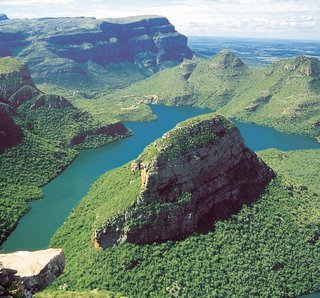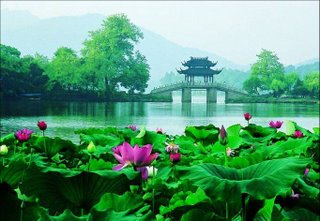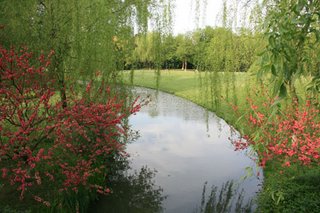 The famous scrolls of Chinese black and white paintings of high mountains, rocks, trees and sea of clouds come alive in Huangshan Mountains in the south Anhui province. It is a marvelous mountain area, now on the UNESCO World Cultural and Natural Heritage List. There is an old saying well known throughout the country "No need to see any other mountains after Huangshan!" Huangshan has spectacular landscape with its four unique scenes: interesting shaped rocks, waterfalls, unique shaped pine trees growing out of rocks, and its sea of clouds. Huangshan has all, the steepness, the grace, the elegance, and so on. Huang Shan Mountain area is such a marvelous place with spectacular vista and its ever-changing scenes attract tourists in all seasons and inspire countless Chinese painters and poets for thousands of years.Of all the notable mountains in China, Mount Huangshan, to be found in the south of Anhui province, is probably the most famous. Originally known as Mt. Yishan it was renamed Mt. Huangshan in 747 AD in recognition of the legendary Huang Di, who was the reputed ancestor of the Chinese people and who made magic pills for immortality here.
The famous scrolls of Chinese black and white paintings of high mountains, rocks, trees and sea of clouds come alive in Huangshan Mountains in the south Anhui province. It is a marvelous mountain area, now on the UNESCO World Cultural and Natural Heritage List. There is an old saying well known throughout the country "No need to see any other mountains after Huangshan!" Huangshan has spectacular landscape with its four unique scenes: interesting shaped rocks, waterfalls, unique shaped pine trees growing out of rocks, and its sea of clouds. Huangshan has all, the steepness, the grace, the elegance, and so on. Huang Shan Mountain area is such a marvelous place with spectacular vista and its ever-changing scenes attract tourists in all seasons and inspire countless Chinese painters and poets for thousands of years.Of all the notable mountains in China, Mount Huangshan, to be found in the south of Anhui province, is probably the most famous. Originally known as Mt. Yishan it was renamed Mt. Huangshan in 747 AD in recognition of the legendary Huang Di, who was the reputed ancestor of the Chinese people and who made magic pills for immortality here.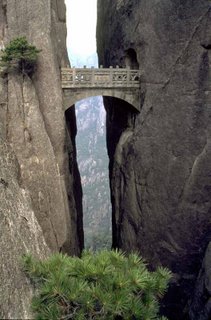 Wu yue is the collective name given to China's most important mountains, namely Mt. Taishan in Shandong Province, Mt. Huashan in Shaanxi Province, Mt. Hengshan in Shanxi Province, Mt. Songshan in Henan Province and Mt. Hengshan in Hunan Province. It is said that you won't want to visit any other mountains after seeing wu yue but you won't wish to see even wu yue after returning from Mt. Huangshan. This saying may give you some idea of the beauty and uniqueness of Mt. Huangshan. Together with the Yellow River, the Yangtze River and the Great Wall, Mt. Huangshan has become one of the great symbols of China.
Wu yue is the collective name given to China's most important mountains, namely Mt. Taishan in Shandong Province, Mt. Huashan in Shaanxi Province, Mt. Hengshan in Shanxi Province, Mt. Songshan in Henan Province and Mt. Hengshan in Hunan Province. It is said that you won't want to visit any other mountains after seeing wu yue but you won't wish to see even wu yue after returning from Mt. Huangshan. This saying may give you some idea of the beauty and uniqueness of Mt. Huangshan. Together with the Yellow River, the Yangtze River and the Great Wall, Mt. Huangshan has become one of the great symbols of China.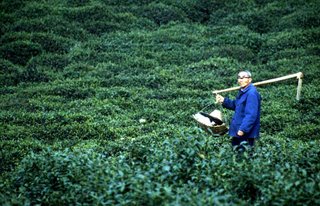 Yellow Mountain, also named Huangshan,is famous for its marvelous and beautiful scenery. It is one of the most popular tourist resorts in China.The landform of Yellow Mountain is a kind of typical granite mountains and forests. It was the result of several movements of lithosphere as well as the work of nature during the long geological age. 77 peaks are more than 1,000 metres above sea level. Granite limestone towers and oddly-shaped rocks spread all over the scenic area.
Yellow Mountain, also named Huangshan,is famous for its marvelous and beautiful scenery. It is one of the most popular tourist resorts in China.The landform of Yellow Mountain is a kind of typical granite mountains and forests. It was the result of several movements of lithosphere as well as the work of nature during the long geological age. 77 peaks are more than 1,000 metres above sea level. Granite limestone towers and oddly-shaped rocks spread all over the scenic area.The legendary pines, oddly-shaped rocks, phantasmagoric sea of clouds, hot springs and winter snows have own Yellow Mountain the world famous reputation of the five unique views. Yellow Mountain has brought together all the strong points other mountains have: grand, strange, baffling, arduous, steep, flourishing, quiet and spacious.There is another noticeable place near Yellow Mountain - Huizhou Culture (also known as Xin'an culture) which is one of the three regional cultures in China. Huizhou Culture includes Xin'an Philosophy, Xin'an Painting School, Xin'an Medicine School, Huizhou Style Architecture, Anhui pot gardening, Huizhou Sculpture, Huizhou Opera, Huizhou Cuisine and so on. It's a miracle of excellent traditional culture of the Chinese nation.
More on China...
